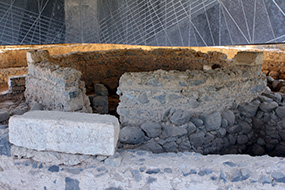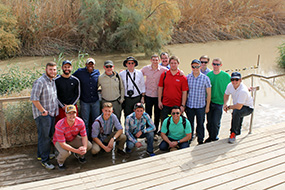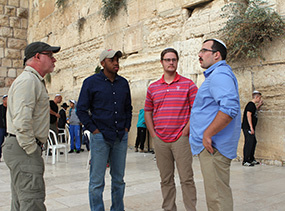As their journey meandered toward Jerusalem, the students on the REL 290 immersion trip to Israel today walked in the footsteps of Jesus, and traveled into the West Bank before settling in behind the walls of the Old City.
The day, which started witnessing sunrise over the Sea of Galilee, managed to stir emotions from both the religious and the political for members of Professor Robert Royalty’s “Contested Texts, Contested Sites” class.
 Marcus Hoekstra ’18, who has visited Israel previously, said the feelings associated with this trip were different largely due to the fact this his in-class experience led him to use scriptures to look at things from a balanced perspective, rather than something solely biblical.
Marcus Hoekstra ’18, who has visited Israel previously, said the feelings associated with this trip were different largely due to the fact this his in-class experience led him to use scriptures to look at things from a balanced perspective, rather than something solely biblical.
“I’m seeing more things from the political side, so I don’t think I’m experiencing the same emotions that I did when I visited Capharnaum previously,” he said. “We’re looking at scripture and viewing the ongoing conflicts objectively.”
The morning visit to Capharnaum set the students off on a learning experience in the footsteps of Jesus, as the stop featured exploration of the house of Saint Peter, where Jesus performed two miracles, and a synagogue, which also dates back to the to the time of Christ.
“It was interesting to see he was from in Nazareth (the class visited there Monday), to where he preached alongside the Sea of Galilee,” said Jimmy Suess ’17. “To go from Capharnaum to Tiberius to other spots along the Sea of Galilee,” “It’s fascinating to walk where he walked and see the beauty that he saw in this place.”
From there, the 19-member group passed through Tiberius en route to Jericho, the oldest city on Earth. The students grabbed lunch (a few even snuck in a camel ride) and toured the ruins, which date to the 8th Century BCE.
 The excursion ventured into Palestine and the West Bank, where the contrast became quickly apparent. One example is agriculture. Due to irrigation techniques, the Israeli side of the River Jordan features plenty of farming, while the Palestinian side is more arid.
The excursion ventured into Palestine and the West Bank, where the contrast became quickly apparent. One example is agriculture. Due to irrigation techniques, the Israeli side of the River Jordan features plenty of farming, while the Palestinian side is more arid.
“Seeing Palestine for the first time, going into the West Bank, seeing the difference in building structures and the aridity of the land vs. the fertility on the Israeli side was a very interesting distinction,” Suess said.
The class also visited two baptismal sites along the River Jordan, one just south of the Sea of Galilee and another that put the group squarely on the Israel-Jordan border. Seeing armed Jordanian military members across the river brought geopolitical thoughts to the forefront, according to Hoekstra.
“Growing up, you look at maps and your conception of borders is kind of just lines until you are standing on one side and you have Jordanian soldiers on the other,” he said. “It expanded for me what the class is about – Contested Texts, Contested Sites – where for a long time we talked about Jerusalem. This is where you realize that this is bigger, it’s between countries as well.”
The day concluded with the drive to Jerusalem, where the group stopped to see the Dome of the Rock and made a visit to the Western Wall. The myriad of emotions there made for a memorable display.
“Seeing the people at the Western Wall are so devout in their faith,” said Greg Sklar ’17. “You can see how much the site means to them,” “There were mixed emotions on display. The history of turmoil and happiness that accompanied the visit ended a powerful day.”
Sklar feels the nine-day excursion is a bit of a final exam for him and his classmates. A semester’s worth of study has led to a richer experience abroad.
“This feels like our final exam, but we are the ones grading it because if we didn’t put in the effort and time to learn everything that we did in class, we wouldn’t respect it to the level we do now,” he concluded. “Anyone can travel the world and see things, but the amount of background understanding we have of it just makes this experience so much better.”